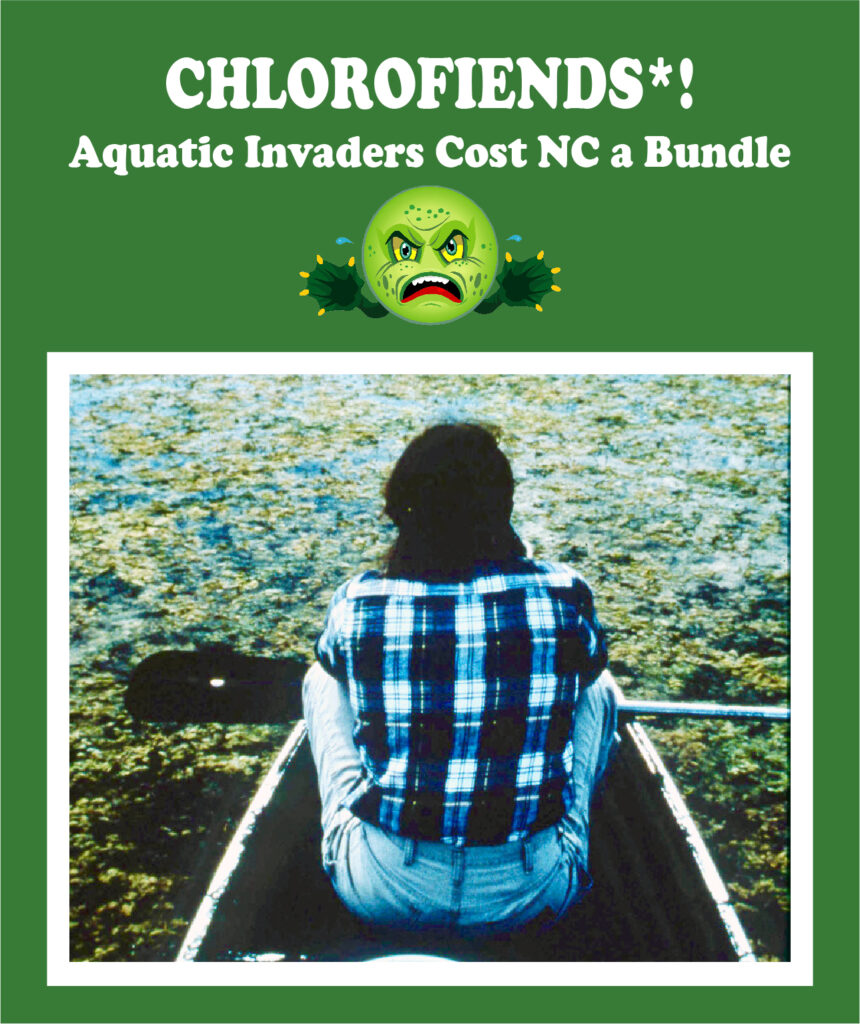By Lisa Lofland Gould
Non-native aquatic invasive plants are Chlorofiends indeed!
The issues surrounding invasive species are complex, and many people don’t “get it”, even when surrounded by landscapes replete with invasive terrestrial plants. Aquatic invaders, however, are another story: suddenly people are horrified that their favorite fishing spots and swimming holes are covered with icky weeds, and appalled at the stink when all that biomass starts to decay. Boaters can’t get through the mess and waterfront homeowners find their property values declining. NOW people are paying attention!
And well they might! Millions of dollars have been spent attempting to control invasive aquatic plants. The economic cost of their impact can be measured in the billions of dollars. The North Carolina Aquatic Nuisance Species Management Plan (NC Aquatic Nuisance Species Management Plan Committee, 2015) cites a 2014 study noting “. . . losses attributed to the presence of just three aquatic nuisance plant species were in excess of $800 million per year.”
What are the impacts?
Some of the costly impacts are obvious. Many aquatic plant invaders form such large mats that boats can’t get through them, impeding swimming as well as recreational and commercial fishing and boating. Less obvious may be the fact that those dense mats keep sunlight from reaching native plants and animals, reduce oxygen levels, and thus disrupt aquatic ecosystems and decrease biodiversity, including killing the fish—and the plants and animals the fish eat—eagerly sought by fishermen.
Large mats of aquatic invasives may cover so much of the water’s surface that there is less open water for birds such as ducks to forage in. These infestations are also perfect mosquito breeding grounds. To the dismay of farmers, these weeds can damage pumping and irrigation equipment. They also impact hydroelectric plants.
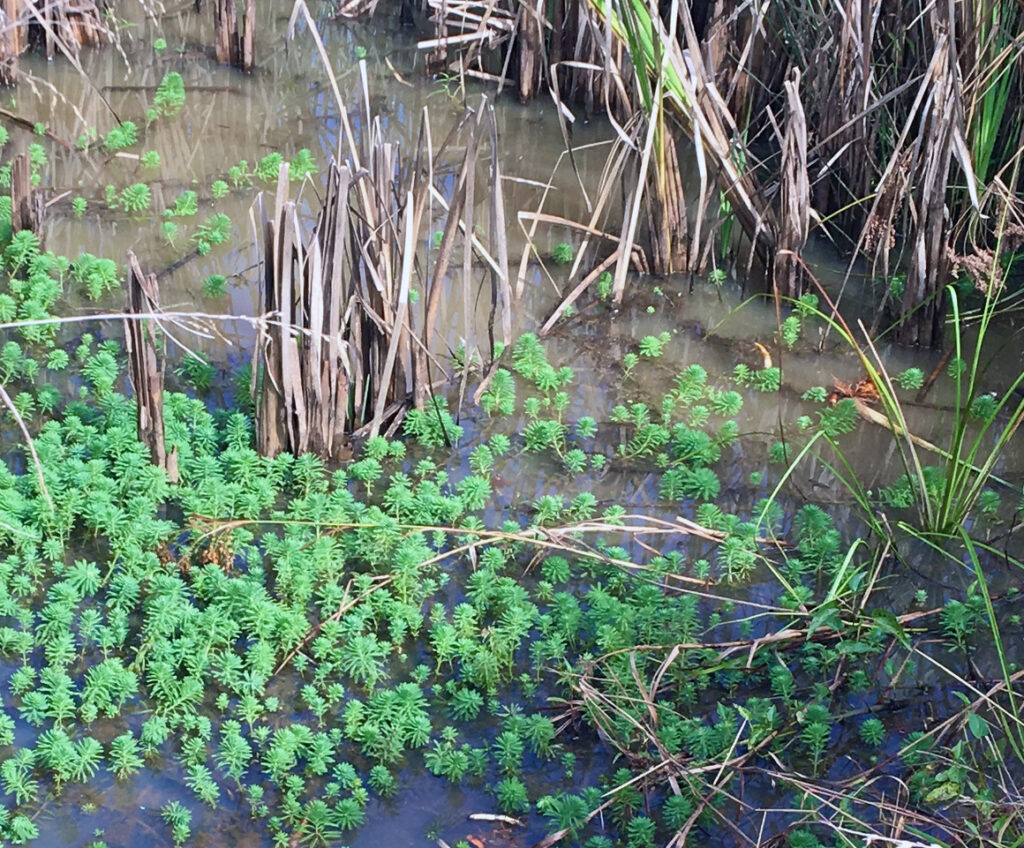
Aquatic invasives spread in many ways. Some, like Water-chesnut (Trapa natans), not yet in NC but in bordering Virginia, produce seeds; the spiny fruits that contain the seeds can cause painful injuries to people and livestock. Others spread from root or stem fragments or even just a single whorl of leaves. Once these plants become established, they are easily spread as hitchhikers on boats and birds’ feathers, and in runoff water during heavy rains and floods.
Many invasives form mats
In North Carolina, mat-forming invasive aquatic plants include Alligator-weed (Alternanthera philoxeroides); Brazilian Waterweed (Egeria densa), sometimes called Elodea or Anacharis, although it is a different plant from our native Elodea; Water-hyacinth(Oshuna crassipes, formerly Eichhornia crassipes); Hydrilla (Hydrilla verticillata); Common Water-primrose (Ludwigia hexapetala);Eurasian Water-milfoil (Myriophyllum spicatum); Parrot-feather (Myriophyllum aquaticum); Water Lettuce (Pistia stratiotes); Curly Pondweed (Potamogeton crispus); and Water Spangles(Salvinia molesta), also known as Aquarium Watermoss or Giant Salvinia).
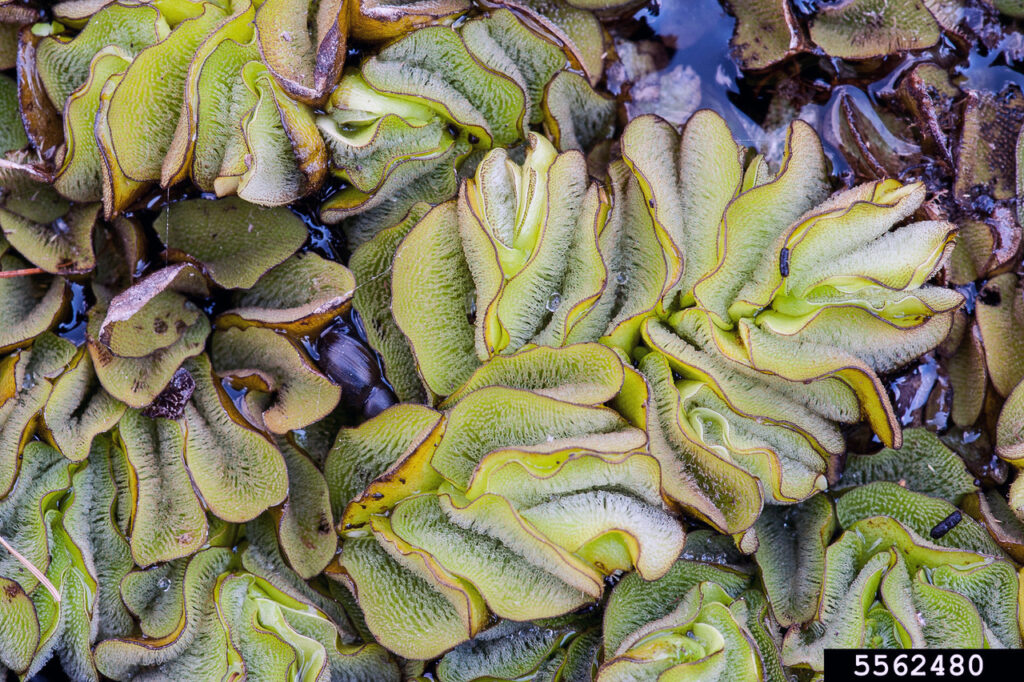
Many of these plants are very fast growing. Water Spangles, a Brazilian native which spreads via buds and stem fragments, can double its population size in just a few days; in only three months, one Water Spangles plant in Louisiana formed a mat that covered 40 square miles.1 Water-hyacinth, a native of tropical America, is considered to have one of the highest growth rates among all vascular plants, able to double its population size in just two weeks1 (it spreads via seeds as well as underwater stems). These are plants on steroids, thriving in warm, high-nutrient (often polluted) waters. Hydrilla can photosynthesize in deep water where there’s little sunlight, growing upward toward the light at a rate of an inch a day; once it reaches the surface it forms branches and spreads over the water.
The Summer 2015 Native Plant News [Note: PDF file] Chlorofiends! article on p.8–9, gives more information on how Hydrilla impacts North Carolina’s waterways and wildlife. The Fall 2016 Native Plant News [Note: PDF file] Chlorofiends! article, p.10, gives more detail about Brazilian Waterweed, Water-primrose, Parrot-feather, and Eurasian Water-milfoil.
Many have escaped into the wild
A number of non-native aquatic plants, including Water-primrose, Hydrilla, Parrot-feather, Water Lettuce, and Sacred Lotus (Nelumbo nucifera) were introduced as ornamentals, to be grown in water gardens and artificial ponds. Water Lettuce is usually killed by cold winter temperatures, but it has been observed to overwinter in the Waccamaw River in South Carolina (Weakley 2022), so it is likely to continue spreading north as climate change brings increasingly warm winters. Sacred Lotus, an Asian native, has almost completely covered a pond near me, impacting a number of bird species (and no doubt, lots of invertebrates) that utilized that wetland.
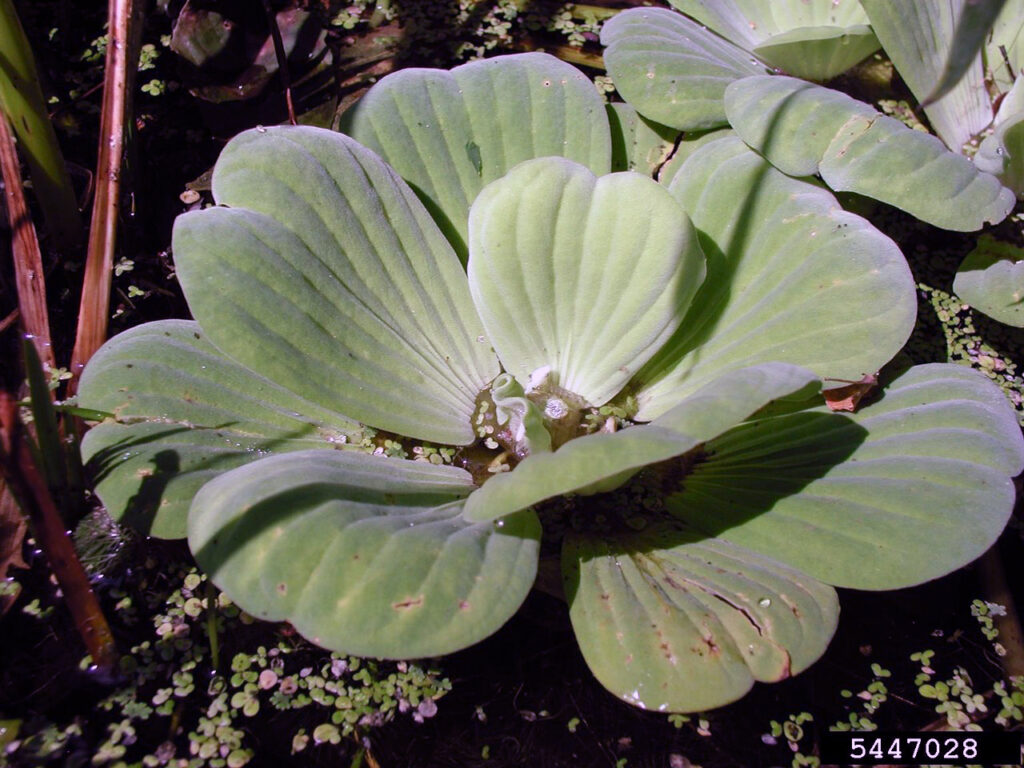
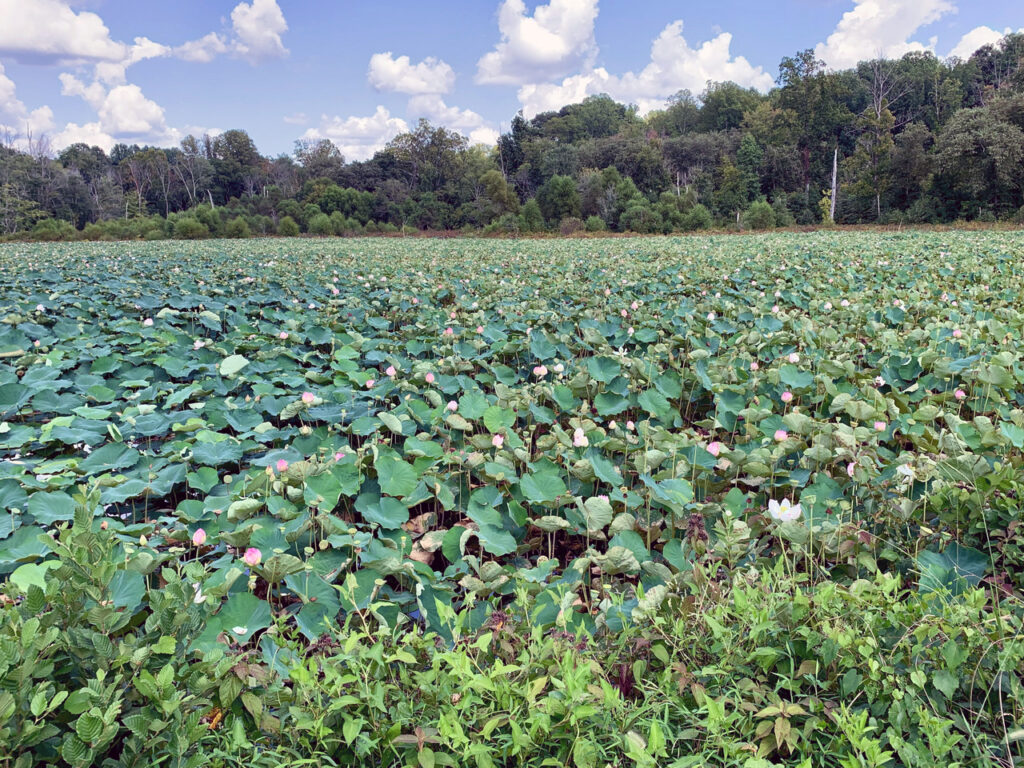
How can commercial vendors help?
Some aquatic invaders were brought in via the aquarium trade, including Curly Pondweed, Brazilian Waterweed, Hydrilla, Water Spangles, and Eurasian Water-milfoil, while Alligator-weed and Eurasian Water-milfoil may have also entered North America in ballast water. Several species are still recommended in the nursery trade as oxygenators (plants that give off oxygen during daytime photosynthesis and help deter algae buildup). Unfortunately, these same plants use oxygen for nighttime respiration, and however useful they may be in aquaria, when they are released into larger water bodies and form dense mats, they reduce oxygen in the water, especially when they decay at the end of their growing season.
Aquarium owners can help
With aquatic invaders, Ben Franklin’s saying, “An ounce of prevention is worth a pound of cure” definitely applies! How can you help? If you have aquaria, never dump the contents into a local water body: many invasive aquatic species have been introduced via the aquarium trade and careless aquarium owners. If you have an outdoor pond, water garden, or rain garden (to help control stormwater runoff), use only native plants. Remember that many aquatic invaders are spread via runoff water and by birds, so even if your plants are contained in an artificial pond or water feature, seeds and fragments can still escape and infest local water bodies.
Great resources for using native plants in aquatic or wetland settings include the Brooklyn Botanic Garden’s The Natural Water Garden: Pools, Ponds, Marshes & Bogs for Backyard Everywhere (BBG Handbook #151, C. C. Burrell (ed.), 1997), and of course, our own Larry Mellichamp’s Native Plants of the Southeast: A Comprehensive Guide to the Best 460 Species for the Garden (Timber Press, 2014), which has a chapter on native aquatic plants.
As always, GO NATIVE!
By Lisa Lofland Gould
Native Plant News – Summer 2023
1 Kaufman, S.R. and W. Kaufman. 2007. Invasive Plants: Guide to Identification and the Impacts and Control of Common North American Species. Stackpole Books, Mechanicsburg PA.

Lisa Gould is a plant ecologist and co-founder of the Rhode Island Wild Plant Society; she currently serves on the NCNPS board of directors and chairs the management committee for the Emily Allen Wildflower Preserve in Winston-Salem.
Chlorofiends! is a regular column in Native Plant News. If you have information or comments on invasive species in North Carolina, please share them with Lisa Gould (lisalgould@gmail.com).
*Thanks to Jim Butcher’s The Dresden Files for the column title.
